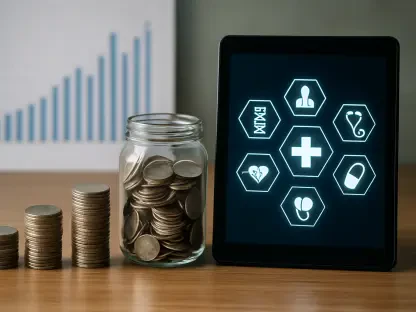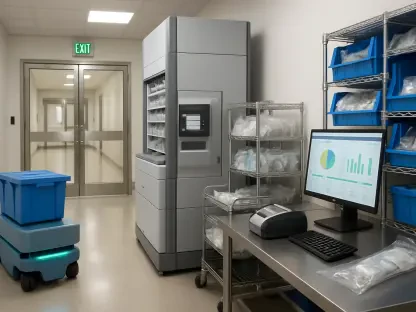The smart wearable healthcare devices market is on track for extraordinary growth, projected to balloon from USD 20.17 billion in 2024 to an anticipated USD 54 billion by 2031, reflecting a significant CAGR of 13.1% from 2024 to 2031. This expansion is significantly influenced by the COVID-19 pandemic, which dramatically accelerated the adoption of affordable health management tools and focused attention on the importance of proactive fitness tracking.
Rising Popularity and Innovations
Extensive Features and Technological Innovations
Smart wearable healthcare devices are becoming increasingly popular because of their versatile features and groundbreaking technological innovations. These gadgets are extensively used in both remote healthcare environments and home setups, providing indispensably continuous monitoring. In managing chronic illnesses such as diabetes and cardiovascular diseases, the continuous monitoring enabled by these devices becomes critical.
Technological advancements have significantly improved the mobility and connectivity capabilities of these devices, enhancing their appeal and subsequently boosting sales. These advancements have presented innovative solutions for patient and disease management, offering seamless integration into daily life. By facilitating better interaction between patients and healthcare providers, these devices contribute substantially to improving the quality of life and healthcare management. Moreover, they help in reducing healthcare costs, which is a significant growth driver for the market.
Impact of COVID-19
The COVID-19 pandemic had a substantial impact on this market. It created an imperative need for constant health monitoring, which was succinctly addressed by wearable technologies. These technologies greatly simplified the process of health monitoring for both patients and healthcare professionals, particularly in remote or isolated areas.
The crisis pushed the adoption and integration of these devices into everyday healthcare practices, leading to significant market growth. Real-time monitoring solutions became particularly important in domestic settings during the pandemic, providing essential health oversight amid restricted movement and high risks of institutional infection. With many people seeking ways to track and manage their health from home, the adoption rate of wearable devices surged, reinforcing their perceived value and importance in modern healthcare.
Market Segmentation
Product Segments
The market is categorized by product types, including blood glucose meters, blood pressure monitors, heart detectors, and pulse monitors. Among these segments, heart detectors have captured the largest market share. This segment’s growth is driven by factors such as the increasing risks associated with leading an inactive lifestyle and the rising prevalence of cardiac conditions among the population.
Advancements in diagnostics and treatment of cardiac diseases have further boosted this segment. Wearable technology in this context, including patches and wearable defibrillators, provides critical care by enabling constant monitoring of cardiac activity. This has proven indispensable for patients who require regular observation to prevent potential heart-related incidents. Enhanced diagnostics and real-time data collection have made these devices an integral part of cardiac care management, offering a profound life-saving capability.
End-User Segments
End-user segmentation divides the market into distinct groups: children, adults, and the elderly. The elderly segment commands the largest market share, driven primarily by the increasing incidence of chronic diseases within the aging population. Chronic illnesses like diabetes and cardiovascular diseases necessitate continuous monitoring, creating a substantial demand for wearable medical devices in this group.
The technology supporting these devices has significantly improved, allowing enhanced travel and communication capabilities for users. These improvements have further fueled the market growth as the elderly population increasingly relies on these devices for their health monitoring needs. The ability of these devices to provide real-time health data contributes to better management of their overall health, reducing hospital visits and increasing their autonomy.
Geographical Insights
North American Market Dominance
Geographically, North America is projected to be the fastest-growing market during the forecast period. This growth is largely attributed to the high penetration of smartphones and smartphone-based healthcare devices in the region. Additionally, rising investments, funds, and grants specific to health tech play a significant role in driving the market.
The continuous influx of advanced technology and substantial capital has positioned North America as a leader in the smart wearable healthcare devices market. The region’s robust healthcare infrastructure, combined with a tech-savvy population, facilitates the rapid adoption of these innovative solutions. These factors create an environment conducive to ongoing market expansion and development, bridging the gap between health monitoring needs and technological offering.
Global Expansion
Beyond North America, other regions such as Europe, Asia Pacific, and the Rest of the World are also experiencing notable growth. This global expansion underscores the worldwide focus on health management and quality care, reflecting a universal need for innovative health monitoring solutions. In Europe and Asia Pacific, rising health awareness and increasing investments in the healthcare sector have spurred market growth.
The technological advancements in these regions have integrated smart wearable healthcare devices into their healthcare systems, providing effective health monitoring and management solutions. This trend indicates a significant shift towards integrated healthcare systems on a global scale, meeting the increasing demand for advanced health monitoring tools.
Key Players and Market Dynamics
Leading Companies
Prominent players in the global smart wearable healthcare devices market include companies like Apple, AT&T, Cyberdyne, Google, I Health Labs, Samsung Electronics, Sprint, Telefonica, and T-Mobile US. These leading companies are capitalizing on technological innovations and strategic investments to cater to the surging demand for wearable healthcare devices.
The strategic maneuvers of these industry giants have driven significant shifts in the market, setting benchmarks for innovation and adoption. By continuously enhancing their product offerings and expanding their market reach, these companies have played a crucial role in propelling the smart wearable healthcare devices market forward.
Market Trends and Drivers
The market for smart wearable healthcare devices is set for remarkable growth, expected to surge from USD 20.17 billion in 2024 to an estimated USD 54 billion by 2031. This impressive increase corresponds to a compound annual growth rate (CAGR) of 13.1% from 2024 to 2031. A significant factor driving this expansion is the COVID-19 pandemic, which has rapidly accelerated the adoption of affordable health management solutions. The pandemic highlighted the critical importance of proactive health monitoring and fitness tracking, leading more consumers to embrace wearable technology for health purposes. These devices not only help in managing chronic diseases but also provide real-time data on various health metrics, empowering individuals to take charge of their own health. Innovations in technology and increasing awareness of personal health are expected to continue fueling the market’s growth. As the demand for better healthcare solutions rises, smart wearable healthcare devices will play an even more pivotal role in the future of health and wellness.









